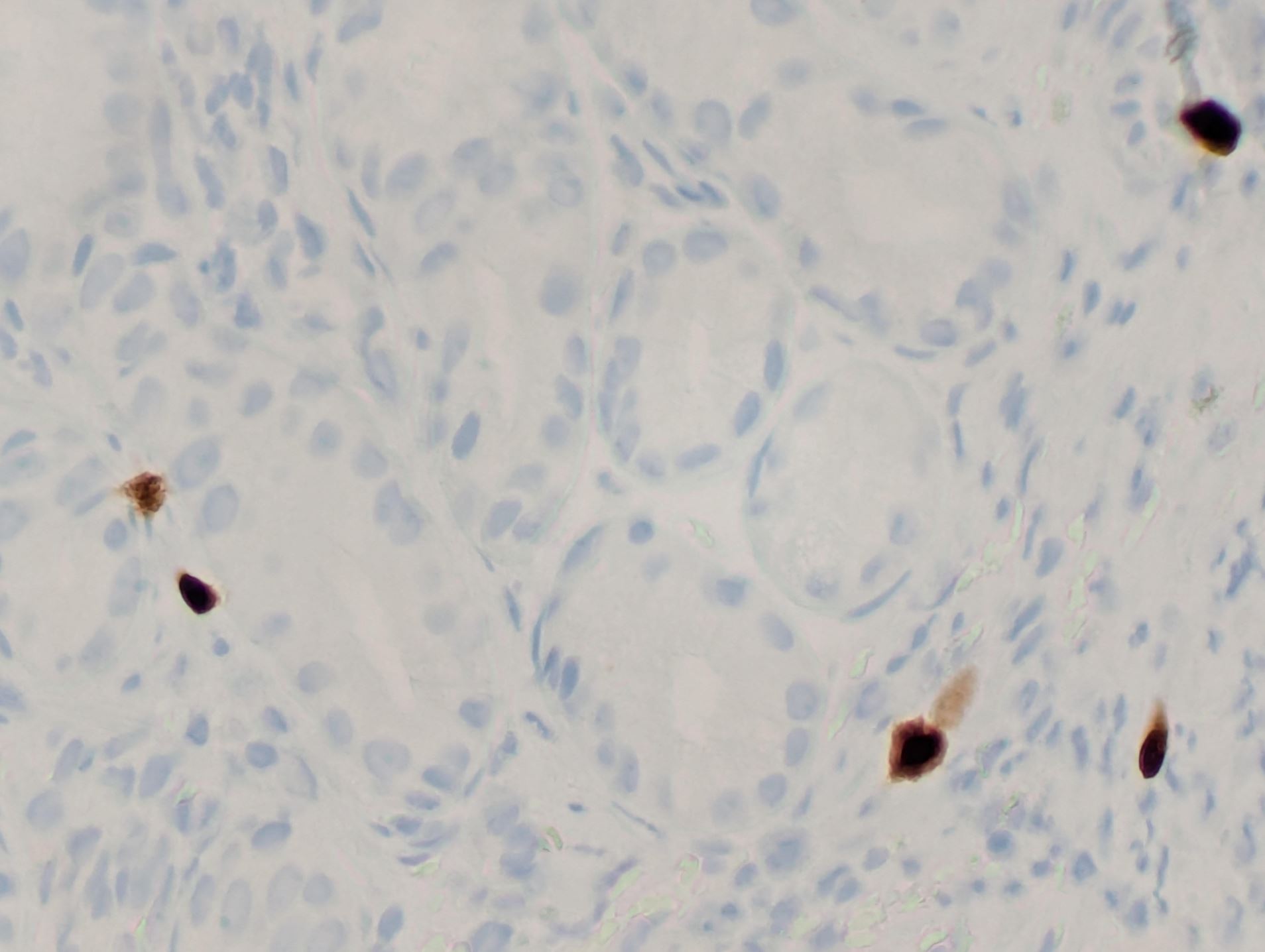Monday Poster Session
Category: Infections and Microbiome
P3474 - Gastric CMV Presenting in an Immunosuppressed Patient With Multiple Sclerosis
Monday, October 27, 2025
10:30 AM - 4:00 PM PDT
Location: Exhibit Hall
- SS
Sinclair Strange, DO (she/her/hers)
UNC Health Blue Ridge
Morganton, NC
Presenting Author(s)
Lauren Shelton, DO1, Sinclair Strange, DO2, Nermila Ballmick, MD2, Nathaniel Krogel, MD2
1UNC Health Blue Ridge, Hickory, NC; 2UNC Health Blue Ridge, Morganton, NC
Introduction: Cytomegalovirus is a common viral infection that is associated with significant disease in immunocompromised patients, including those on immunomodulating medications. It can cause a broad range of clinical disease including hepatitis, esophagitis, and colitis. When associated with gastritis, symptoms can include epigastric pain, nausea/vomiting, fever and rarely hematemesis. We present a case of biopsy positive gastric CMV in a patient with MS receiving treatment with natalizumab.
Case Description/
Methods: A 65-year-old female with a history of GERD on omeprazole twice daily and multiple sclerosis on natalizumab presented to the ED with abdominal bloating and epigastric pain. Vital signs were within normal limits. Labs were notable for mild LFT elevations. A CT abdomen/pelvis with contrast was unremarkable except for a mildly enlarged spleen. Abdominal ultrasound was unremarkable. As workup was largely negative, she was discharged and followed up outpatient where she was started on dexlansoprazole. An EGD was performed, notable for gastritis and a fundic gastric polyp. Gastric biopsies obtained showed scattered positively staining structures suggestive of CMV inclusions. After following up with ID and further workup revealed CMV viral load of less than 200 with negative antibodies. After discussion with transplant infectious disease, it was determined that given the above results, there was no concern for invasive CMV. As the patient reported significant improvement in her GI symptoms, was otherwise asymptomatic and had resolution of transaminitis, she did not undergo antiviral treatment.
Discussion: GI CMV most often manifests in the colon and stomach of immunosuppressed patients. It is important to distinguish between infective vs disease states. Infection refers to detection of the virus through antigen testing or detection of nucleic acid in tissue or fluid and does not always transition into active disease. Disease state refers to patients with active symptoms such as fever, leukopenia, or tissue involvement. The gold standard for diagnosis of tissue invasive disease is biopsy with positive staining or CMV inclusion identification. With GI disease, DNA load testing can be negative, so diagnosis relies on evaluation of a tissue biopsy. There is typically a good response to treatment with ganciclovir. While our patient significantly improved without need for antiviral treatment, this case further emphasizes the importance of monitoring for atypical infections in immunocompromised patients.

Figure: CMV inclusion cells with positive staining.
Disclosures:
Lauren Shelton indicated no relevant financial relationships.
Sinclair Strange indicated no relevant financial relationships.
Nermila Ballmick indicated no relevant financial relationships.
Nathaniel Krogel indicated no relevant financial relationships.
Lauren Shelton, DO1, Sinclair Strange, DO2, Nermila Ballmick, MD2, Nathaniel Krogel, MD2. P3474 - Gastric CMV Presenting in an Immunosuppressed Patient With Multiple Sclerosis, ACG 2025 Annual Scientific Meeting Abstracts. Phoenix, AZ: American College of Gastroenterology.
1UNC Health Blue Ridge, Hickory, NC; 2UNC Health Blue Ridge, Morganton, NC
Introduction: Cytomegalovirus is a common viral infection that is associated with significant disease in immunocompromised patients, including those on immunomodulating medications. It can cause a broad range of clinical disease including hepatitis, esophagitis, and colitis. When associated with gastritis, symptoms can include epigastric pain, nausea/vomiting, fever and rarely hematemesis. We present a case of biopsy positive gastric CMV in a patient with MS receiving treatment with natalizumab.
Case Description/
Methods: A 65-year-old female with a history of GERD on omeprazole twice daily and multiple sclerosis on natalizumab presented to the ED with abdominal bloating and epigastric pain. Vital signs were within normal limits. Labs were notable for mild LFT elevations. A CT abdomen/pelvis with contrast was unremarkable except for a mildly enlarged spleen. Abdominal ultrasound was unremarkable. As workup was largely negative, she was discharged and followed up outpatient where she was started on dexlansoprazole. An EGD was performed, notable for gastritis and a fundic gastric polyp. Gastric biopsies obtained showed scattered positively staining structures suggestive of CMV inclusions. After following up with ID and further workup revealed CMV viral load of less than 200 with negative antibodies. After discussion with transplant infectious disease, it was determined that given the above results, there was no concern for invasive CMV. As the patient reported significant improvement in her GI symptoms, was otherwise asymptomatic and had resolution of transaminitis, she did not undergo antiviral treatment.
Discussion: GI CMV most often manifests in the colon and stomach of immunosuppressed patients. It is important to distinguish between infective vs disease states. Infection refers to detection of the virus through antigen testing or detection of nucleic acid in tissue or fluid and does not always transition into active disease. Disease state refers to patients with active symptoms such as fever, leukopenia, or tissue involvement. The gold standard for diagnosis of tissue invasive disease is biopsy with positive staining or CMV inclusion identification. With GI disease, DNA load testing can be negative, so diagnosis relies on evaluation of a tissue biopsy. There is typically a good response to treatment with ganciclovir. While our patient significantly improved without need for antiviral treatment, this case further emphasizes the importance of monitoring for atypical infections in immunocompromised patients.

Figure: CMV inclusion cells with positive staining.
Disclosures:
Lauren Shelton indicated no relevant financial relationships.
Sinclair Strange indicated no relevant financial relationships.
Nermila Ballmick indicated no relevant financial relationships.
Nathaniel Krogel indicated no relevant financial relationships.
Lauren Shelton, DO1, Sinclair Strange, DO2, Nermila Ballmick, MD2, Nathaniel Krogel, MD2. P3474 - Gastric CMV Presenting in an Immunosuppressed Patient With Multiple Sclerosis, ACG 2025 Annual Scientific Meeting Abstracts. Phoenix, AZ: American College of Gastroenterology.
